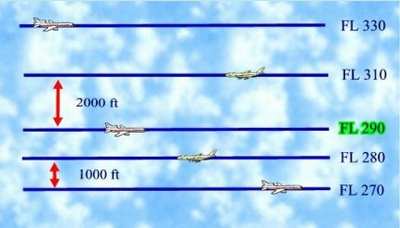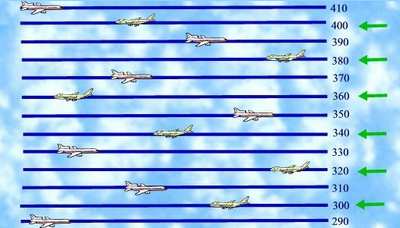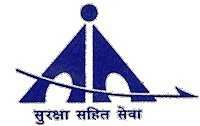RVSM: India Having Troubles "Multi-Laning" Air
Traffic
 A few
foreign reports caught our eye as Indian aviation officials
have tried (in vain, at times) to deal with the realities
of RVSM (Reduced Vertical Separation Minimum) implementation.
Media reports tried to describe it as something akin
to widening a major highway from two lanes to eight, while
missing the complexities of the issues involved in running more
"heavy" traffic in less airspace, safely and efficiently (the
backbone of the RVSM concept.).
A few
foreign reports caught our eye as Indian aviation officials
have tried (in vain, at times) to deal with the realities
of RVSM (Reduced Vertical Separation Minimum) implementation.
Media reports tried to describe it as something akin
to widening a major highway from two lanes to eight, while
missing the complexities of the issues involved in running more
"heavy" traffic in less airspace, safely and efficiently (the
backbone of the RVSM concept.).
For many years, aircraft above 28,000 feet have been separated
by at least 2000 feet since barometric errors made such
tolerances a necessary evil (as seen in the graphic below...).

Worse, as altitude increased, the accuracy of pressure
sensing Barometric altimeters basically went to hell. In
1960, decision were made to increase separation at and
above Flight Level (FL) 290 from 1000 ft to 2000 ft. ICAO adopted a
standard global FL290 changeover level in 1966. Recently; as
technology allowed for better differentiation and determination of
actual altitude, the 2000 foot separations inherent in high
altitude air travel came to (properly) be viewed as a "waste of
space."
Hence, RVSM
Already implemented in nearby Europe and North Africa
(and proceeding at a snail's pace in the USA),
since January of 2002, the Reduced Vertical Separation
Minimum in European Airspace has provided six
additional flight levels between 29,000 feet (FL290) and 41,000
feet (FL410) inclusive. Below 28,000 feet This has been achieved by
reducing the separation minimums between aircraft from 2,000 ft to
just 1,000 ft. The RVSM Programme has been implemented
simultaneously in the airspace of some 41 European and North
African countries.

The Airports Authority of India (AAI) has decided to adopt this
"multi-lane" system to expand available commercial air routes
across the nation. The adoption of RVSM protocols boosts the
number of flights in the air at the same time and, hopefully,
boosts the number of paying passengers going from Point A to Point
B.
Here's The Catch
 Airlines operating in India are just now starting to get with
the RVSM program and trouble is brewing. "Four-laning or
eight-laning of roads increases efficiency, cuts down travelling
time and eases traffic flow, multiple-laning of the existing air
corridor will have the same effect," explains AAI Member
(Operations) K. Ramalingam,somewhat simplistically. Already,
the number of routes available across India has grown dramatically.
More expansion is expected. But... these protocols require new
procedures, equipment (in the aircraft as well as in the air
traffic facilities monitoring them) and special certification.
Airlines operating in India are just now starting to get with
the RVSM program and trouble is brewing. "Four-laning or
eight-laning of roads increases efficiency, cuts down travelling
time and eases traffic flow, multiple-laning of the existing air
corridor will have the same effect," explains AAI Member
(Operations) K. Ramalingam,somewhat simplistically. Already,
the number of routes available across India has grown dramatically.
More expansion is expected. But... these protocols require new
procedures, equipment (in the aircraft as well as in the air
traffic facilities monitoring them) and special certification.
Controllers Grumbling
 Over the past six months, 21 countries have
adopted RVSM systems and procedures, many of them reporting some
amount of difficulty in merging new routes and procedures with the
older, more familiar, less restrictive ones. Such is the case in
India - especially in the northern part of the country. "It is like
a village lane merging with a highway. This hampers movement on the
main corridor and increases pressure on the controller," said a
senior AAI official.
Over the past six months, 21 countries have
adopted RVSM systems and procedures, many of them reporting some
amount of difficulty in merging new routes and procedures with the
older, more familiar, less restrictive ones. Such is the case in
India - especially in the northern part of the country. "It is like
a village lane merging with a highway. This hampers movement on the
main corridor and increases pressure on the controller," said a
senior AAI official.
But the controllers themselves are reported to be grumbling
about RVSM, saying they were never issued proper manuals or
guidelines. In fact, they say, the only people who've been
briefed on the new procedures are the most senior of air traffic
officials - and even those guidelines have been termed
"sketchy."
 NTSB Prelim: Piper PA-23
NTSB Prelim: Piper PA-23 Classic Aero-TV: One Mans Vietnam
Classic Aero-TV: One Mans Vietnam NTSB Final Report: Capella Aircraft Corp FW1C50
NTSB Final Report: Capella Aircraft Corp FW1C50 Classic Aero-TV: Timber Tiger Touts Curtiss Jenny Replicas
Classic Aero-TV: Timber Tiger Touts Curtiss Jenny Replicas ANN's Daily Aero-Term (07.04.25): Performance-Based Navigation (PBN) [ICAO]
ANN's Daily Aero-Term (07.04.25): Performance-Based Navigation (PBN) [ICAO]






